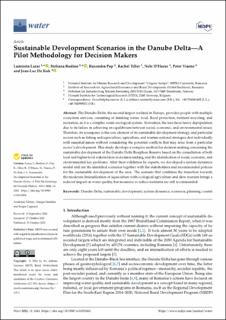Sustainable Development Scenarios in the Danube Delta—A Pilot Methodology for Decision Makers
| dc.contributor.author | Lazar, Luminita | |
| dc.contributor.author | Rodino, Steliana | |
| dc.contributor.author | Pop, Ruxandra | |
| dc.contributor.author | Tiller, Rachel | |
| dc.contributor.author | D’Haese, Nele | |
| dc.contributor.author | Viaene, Peter | |
| dc.contributor.author | De Kok, Jean-Luc | |
| dc.date.accessioned | 2023-01-12T12:19:56Z | |
| dc.date.available | 2023-01-12T12:19:56Z | |
| dc.date.created | 2022-12-02T09:14:16Z | |
| dc.date.issued | 2022 | |
| dc.identifier.citation | Water. 2022, 14 (21), 1-22. | en_US |
| dc.identifier.issn | 2073-4441 | |
| dc.identifier.uri | https://hdl.handle.net/11250/3043029 | |
| dc.description.abstract | The Danube Delta, the second-largest wetland in Europe, provides people with multiple ecosystem services, consisting of drinking water, food, flood protection, nutrient recycling, and recreation, as it is a complex social–ecological system. Nowadays, the area faces heavy depopulation due to its failure in achieving an equilibrium between social, economic, and environmental issues. Therefore, its resurgence is the core element of its sustainable development strategy, and particular sectors such as fishing and aquaculture, agriculture, and tourism national strategies deal individually with essential issues without considering the potential conflicts that may arise from a particular sector’s development. This study develops a complex method for decision making concerning the sustainable development of the Danube Delta Biosphere Reserve based on the consultation of both local and higher-level stakeholders in decision making, and the identification of social, economic, and environmental key problems. After their validation by experts, we developed a system dynamics model and ran the identified scenarios together with the stakeholders and recommended policies for the sustainable development of the area. The scenario that combines the transition towards the moderate Intensification of aquaculture with ecological agriculture and slow tourism brings a reduced impact on water quality, but measures to reduce nutrients are still recommended. | en_US |
| dc.language.iso | eng | en_US |
| dc.publisher | MDPI | en_US |
| dc.rights | Navngivelse 4.0 Internasjonal | * |
| dc.rights.uri | http://creativecommons.org/licenses/by/4.0/deed.no | * |
| dc.subject | coastal | en_US |
| dc.subject | planning | en_US |
| dc.subject | scenarios | en_US |
| dc.subject | system dynamics | en_US |
| dc.subject | development | en_US |
| dc.subject | sustainable | en_US |
| dc.subject | Danube Delta | en_US |
| dc.title | Sustainable Development Scenarios in the Danube Delta—A Pilot Methodology for Decision Makers | en_US |
| dc.title.alternative | Sustainable Development Scenarios in the Danube Delta—A Pilot Methodology for Decision Makers | en_US |
| dc.type | Peer reviewed | en_US |
| dc.type | Journal article | en_US |
| dc.description.version | publishedVersion | en_US |
| dc.rights.holder | Copyright: © 2022 by the authors. Licensee MDPI, Basel, Switzerland. This article is an open access article distributed under the terms and conditions of the Creative Commons Attribution (CC BY) license (https:// creativecommons.org/licenses/by/ 4.0/). | en_US |
| dc.source.pagenumber | 1-22 | en_US |
| dc.source.volume | 14 | en_US |
| dc.source.journal | Water | en_US |
| dc.source.issue | 21 | en_US |
| dc.identifier.doi | 10.3390/w14213484 | |
| dc.identifier.cristin | 2087548 | |
| dc.relation.project | EC/H2020/773782 | en_US |
| cristin.ispublished | true | |
| cristin.fulltext | original | |
| cristin.qualitycode | 1 |
Tilhørende fil(er)
Denne innførselen finnes i følgende samling(er)
-
Publikasjoner fra CRIStin - SINTEF Ocean [1386]
-
SINTEF Ocean [1460]

